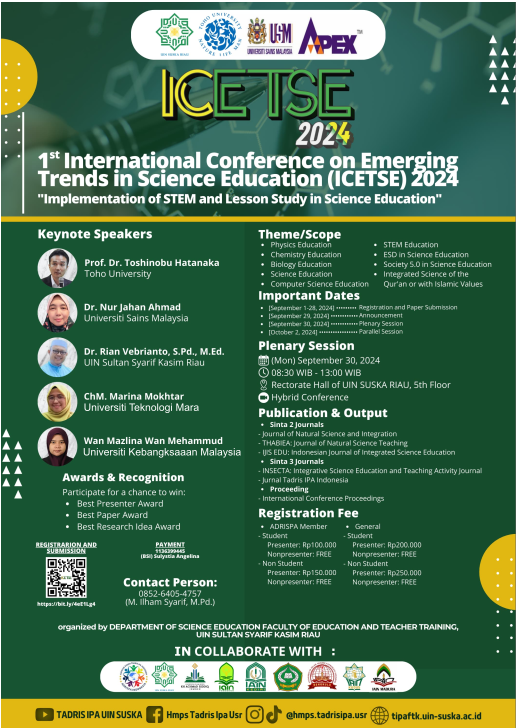Development of a Teaching Module on Classification of Living Things Based on Biodiversity Analysis at Irenggolo Waterfall
Main Article Content
Abstract
This research aims to develop a teaching module on the classification of living organisms to facilitate students' understanding of the subject. The study employs the Research & Development (R&D) method using the 4D model, which consists of four stages: Define, Design, Develop, and Disseminate. In the Define stage, the researcher conducts an initial analysis to identify problems in the teaching of science, specifically on the topic of classification of living organisms. In the Design stage, the researcher designs the teaching module that will be developed. During the Develop stage, the teaching media and materials are created according to the designed plan and are then validated by subject matter experts and media experts. In the Disseminate stage, the product is distributed through schools. The developed teaching module received a media validation score with a validity percentage of 72%, categorized as highly valid and suitable for use. The content validation showed a validity percentage of 96.7%, also categorized as highly valid and suitable for use. In addition to expert validation, the feasibility of the media was also assessed based on student response surveys, which showed a percentage of 94% with a criterion of highly suitable. Based on the reliability test results, it was found that the Cronbach's Alpha value was 0,651 with a total of 20 items tested. Since the Cronbach's Alpha value is greater than 0.60, it can be concluded that the research instrument has an adequate level of reliability and consistency in measuring the variables being studied variables.
Article Details
References
Arikunto, S. (2013). Research Procedure: A Practical Approach (Revised Edition). Jakarta: Rineka Cipta.
Astuti, Rina. 2018. "Development of Inquiry-Based Science Modules to Improve Science Process Skills of Junior High School Students." Journal of Mathematics and Natural Sciences Education, 4(1): 102-110.
Budiarto, M., & Rachmawati, T. (2018). Science Education: A Contextual Approach to Understanding Biodiversity. Jakarta: Erlangga Publishers.
Kediri Regency Tourism Office. (2022). Irenggolo Waterfall: The Charm of Natural Tourism in Kediri. Kediri: Kediri Regency Tourism Office.
Hadi, S. "Data Analysis in Research: Methods and Techniques." In Journal of Educational Research and Evaluation, vol. 14, no. 1, 2023, pp. 50-60.
Hartono, R. (2022) "4D Development Model in the Preparation of Student Worksheets (TEACHING MODULE): Approaches and Applications." In Journal of Education and Learning, vol. 15, no. 2, pp. 55-65.
Hidayat, M. (2021) Statistics for Educational Research: Reliability and Validity Test. Jakarta: RajaGrafindo Publishers.
Irawan, R. (2021) "Species Diversity in Indonesia's Tropical Forest Ecosystem." In Journal of Tropical Biology, vol. 8, no. 1, pp. 20-30.
Kurniawan, M. (2022) "The Role of Environmental Factors in Aquatic Biodiversity: A Case Study on Waterfall Ecosystems." In Journal of Ecology and Conservation, vol. 11, no. 1, pp. 60-70.
Kusuma, Dewi. (2020). "Implementation of Environment-Based Science Learning to Improve Students' Science Process Skills." Journal of Science Education Innovation, 6(3): 197-205.
Lestari, A. (2022) Adaptation of Flora and Fauna Species in the Waterfall Environment. Surabaya: Universitas Airlangga Press.
LIPI. (2022) "Biodiversity in Indonesia." In LIPI Bulletin: Biodiversity, vol. 15, no. 2, pp. 40-55.
Manan, Abdul. (2020) Biodiversity: Concepts and Applications. Jakarta: Natural Sciences Publisher,
Nugroho, H. (2021) "The Relationship between Water Quality and Biodiversity in Waterfall Ecosystems." In Journal of Environment and Forestry, vol. 10, no. 1, pp. 30-40.
Okpatrioka. (2023). Research and Development (R&D) Innovative Research in Education. DHARMA ACARIYA NUSANTARA: Journal of Education, Language and Culture, Vol. 1, No. 1.
Pramudito, L. (2023) "Competency-Based Learning in the Independent Curriculum: Approach and Implementation." In Indonesian Education Journal, vol. 18, no. 1, pp. 70-80.
Prasetya, S. "The Influence of Environmental Factors on Biodiversity in the Waterfall Area." In Indonesian Journal of Ecology, vol. 12, no. 2, 2022, pp. 50-65. (n.d.).
Rahayu, S. (2019). "Exploring the Potential of Natural Tourism in Kediri Regency." Culture and Tourism Bulletin, 12(2), 33-41.
Rahmat, Andi. (2020). "The Use of Digital Modules in Ecology Learning to Improve Student Understanding." Journal of Educational Technology, 8(4): 232-240.
Rohmah, Siti. (2018). "Analysis of Biodiversity in Waterfall Ecosystems as a Source of Science Learning." Indonesian Journal of Biology Education, 4(1): 55-65.
Santoso, Agus. (2019). "Development of Ecosystem-Based Learning Modules to Improve Student Understanding." Journal of Science Education, 7(2): 142-150.
Sukardi. (2013). Educational Research Methodology. Jakarta: Bumi Aksara.
Suryadi, R. (2023) "Implementation of the Independent Curriculum: Teacher and School Autonomy in Learning." In Journal of Education and Teaching, vol. 17, no. 2, pp. 40-50.
Wahyudi, T., & Kurniawan, D. (2019). The Role of Waterfall Ecosystems in the Conservation of the Environment and Water Resources. Journal of Ecology and Conservation, 15(2), 135-148.
Wahyuni, T. P., dkk. (2022). Biologi SMA Tenth Grade. Padang: GET Press Indonesia.
Wardhana, T. (2022)"Classification of Living Things: Principles and Applications in Indonesia." In Indonesian Journal of Biology, vol. 16, no. 2, pp. 85-95.
Wibowo, Budi. (2021). "The Effectiveness of Project-Based Learning Modules in Improving the Understanding of Biology Concepts of Junior High School Students." Journal of Biology Education, 5(2): 88-96.
Wibowo, H. (2022) "The Role of Riverside Ecosystems in Land Fauna Diversity Around Waterfalls." In Journal of Ecology and Biodiversity, vol. 13, no. 3, pp. 85-95.
Wiranata, A. (2020). "The Exoticism of Irenggolo Waterfall on the Slopes of Mount Wilis." Journal of Nusantara Tourism, 8(1), 45-60.
